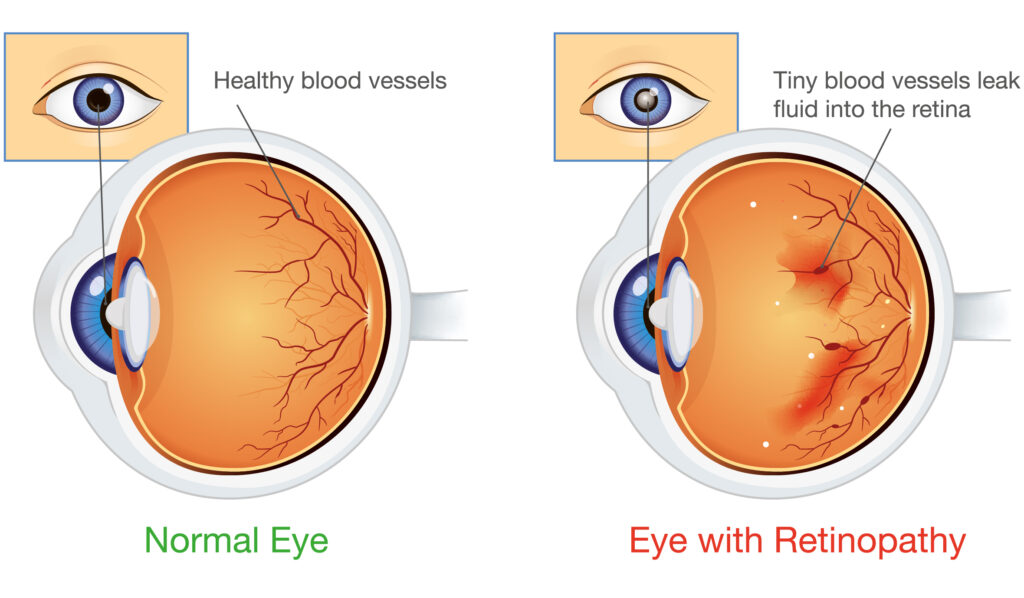What is Diabetic Retinopathy?
Diabetic Retinopathy (DR) is a complication of diabetes which affects small blood vessels in the back of the eye (the retina). High blood glucose levels can cause the tiny blood vessels in the retina to become blocked. When this happens, the eye compensates for the reduced blood supply by growing new blood vessels which are fragile and can leak. The retina is the seeing part of the eye, if it is damaged it can affect vision. If left untreated, this can cause irreversible sight loss or blindness.
Prevention and Treatment
This is a progressive condition, but early eye damage can be paused or ‘reversed’.
The main preventative measures are to monitor and manage blood glucose levels, blood pressure and cholesterol. They may be on medications to help reduce their risks and eating a balanced diet and keeping as active as they can will also help.

Screening for Diabetic Retinopathy
- People with diabetes should access regular retinopathy eye screening appointments as well as routine eye tests with an optician. Any visual problems should be investigated by an optician or optometrist rather than waiting for an eye screening appointment.
- Diabetic Eye screening involves photographs being taken of the back of the eye using a special camera, after eye drops have been given to make the pupils dilate. The eye drops can feel uncomfortable and will cause blurred vision for around 4- 6 hours.
- The full screening appointment takes between 40 minutes and an hour. It takes around 5-10 minutes for the eye images to be captured. The person being screened will need to remain in a seated position at the camera, keeping their head still and moving their eyes as instructed for clear photographs to be captured.
- The eye images are then assessed for the signs of Diabetic Retinopathy (DR). Most people are recalled for routine screening every 1-2 years, but around 1 in 50 people that have the test will be referred to an eye specialist for investigation or treatment of their retinopathy.
Advice should be sought from the DESW nursing team before attending clinic, by calling the DESW helpline on the appointment letter and on 03000 030 500.
Alternatively, you can email them via diabetic-eye-screening@wales.nhs.uk or visit phw.nhs.wales/services-and-teams/screening/diabetic-eye-screening-wales/ for further information. 1People with diabetes who drive to appointments and the use of eye drops Guidance (updated March 2024) https://www.gov.uk/government/publications/diabetic-eye-screening-patients-who-drive-to-appointments/diabetic-eye-screening-patients-who-drive-to-appointments (accessed 22/07/2024).
- Screening does not prevent retinopathy, but can identify it at an early stage when treatment is more effective.
- Attending screening is a choice. Some people choose not to, or cannot attend screening appointments. They will still be invited to eye screening again as long as they are:
– not completely blind in both eyes
– have not opted out of the service
– have not been assessed as unable to receive screening
- People who cannot attend a community based clinic are unable to receive screening e.g.
– those who cannot remain still
– who cannot lean forward
– and/or who are unable to follow instructions may be unable to receive screening
Retinopathy can be treated. It is essential to have regular eye screening.
Watch the Retinal Screening Film here:
Retinal Screening
Other Eye Conditions
People with diabetes may also be at increased risk from cataracts and glaucoma. The risk of these conditions increases with age, and for people with diabetes
Cataracts
Cataracts are caused when the lens in the eye develops cloudy patches. This causes:
- Clouded or blurred vision
- Double vision
- Difficulty in seeing when light levels are low
- Sensitivity to light and glare
Glaucoma
Glaucoma is caused by increased pressure inside the eye and can damage the optic nerve. Warning signs are:
- Loss of peripheral or side vision
- Seeing halos around lights
- Blurred vision
16 Diabetic Retinopathy & Eye Screening
- 1People with diabetes who drive to appointments and the use of eye drops Guidance (updated March 2024) https://www.gov.uk/government/publications/diabetic-eye-screening-patients-who-drive-to-appointments/diabetic-eye-screening-patients-who-drive-to-appointments (accessed 22/07/2024).